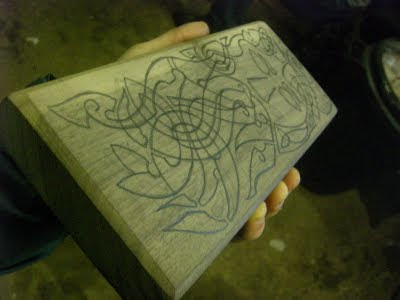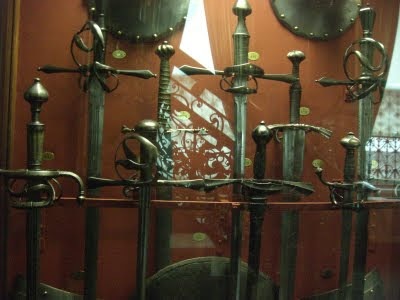Essentially, the rest of the class was spent making our own designs, and carving them as a large final project. Mine was this entirely original intertwined-beard-hair man, inspired by the general spirit of wise, old bearded traveling men or gods, such as Odin, who is sometime similarly

After the layout, I began to carve away the negative space, leaving my man and his hair-tangle flat.

After that I rounded it. This is so incredibly simple to explain, it feels, but it took my several days, with at least six hours of solid work in each day. It never felt like work, however, letting my muse drive me and the company of my fellows cheer me.

Later, I got to see some more of Owen's masterpieces, including this pattern-welded blade of otherworldly beauty:

This seax blade is beyond comprehension in its complexity and wonder:

The week culminated in Owen's annual Forge-In, where smiths and other craftsmen from all over the world came to talk, eat, exchange ideas, and do demonstrations of their craft. Once again, in an unbelievably short time, I learned an unfathomable amount.
One demonstrator was
Leo Todeschini of Tod's Stuff, a jack-of-all-trades as it were, at least in the area of medieval crafts. Below is a 15th c. German knife called a bauernwehr he made, with scabbard and by-knife and fittings and blade and handle an all.

His demonstration was in scabbard making. He showed us to wet the leather, but not soak it, shape it roughly to the blade, cut it, sew it with waxed string and a thick needle, score designs with a razor and then amplify them with a hard but rounded piece of bone or plastic, and sew it all up. He added designs by scoring and deepening and also using little stamps he cut himself.

Another demonstrator was the supremely talented
Petr Florianek of the Czech Republic. He demonstrated his carving with bone and antler, remarkably similar to ours with wood, but with a very differently grained medium. He used some chisels but primarily wielded the Dremel, and then rubbed his carvings with some kind of ochre to emphasize patterns.

One ongoing event which people attended and helped with as they pleased was the smelting of pig iron from iron ore by one Jeff Pringle, a talented sword- and bladesmith in his own right, and a veritable authority on Iron-age and Viking industrial techniques. He is a bladesmith with whom I hope to work this summer in Oakland, CA, where he and my uncle both live. I have known him for many years and he was actually the first swordsmith I ever met!

It was with a heavy heart that I left, but with a mind so full of ideas and a passion ablaze.



























 I assumed this position often as well, checking for the uniformity of my bevels from the belt grinder. Grinding took probably half as long again as forging, and I used belts of increasing grit, beginning with 60 and going up to 400.
I assumed this position often as well, checking for the uniformity of my bevels from the belt grinder. Grinding took probably half as long again as forging, and I used belts of increasing grit, beginning with 60 and going up to 400. 























